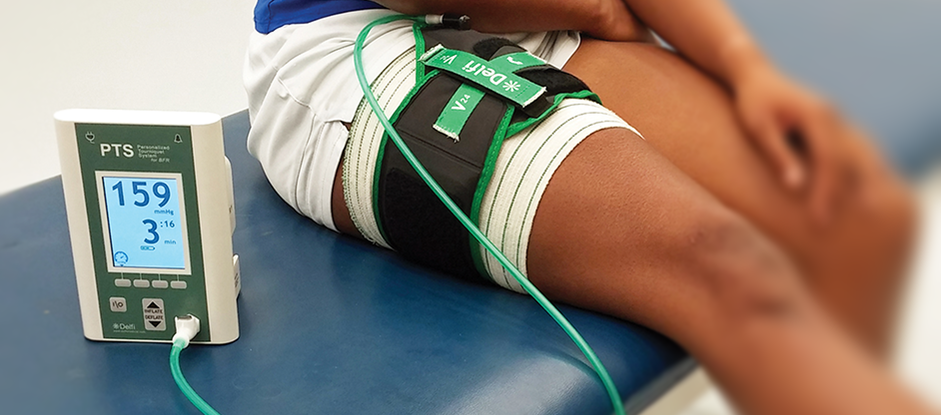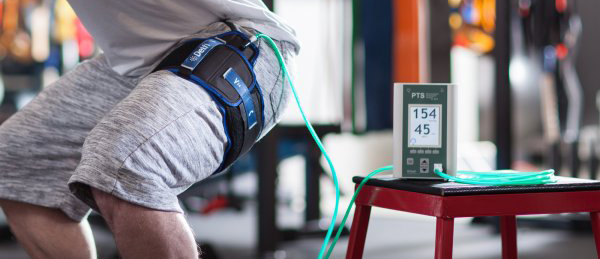Blood Flow Restriction Therapy: An Innovative Technique That Can Help You in Your Recovery
by Christina Mogelnicki, PT, DPT


You may not have heard of it yet, but Blood Flow Restriction (BFR) Training is taking off in the physical therapy world as a useful technique that helps patients recover from injuries faster and more effectively – especially those who struggle with lifting weights due to age, severity of injury or other limitations. If used correctly, this innovative, scientifically-backed technique can be an essential part of your rehabilitation.
The Theory
The theory behind BFR is to partially restrict blood flow from a limb back to the heart during light weightlifting using an elastic band or cuff. This also affects arterial flow – blood flow from the heart to the limbs – to a lesser extent. This blockage deprives the muscle tissues of oxygen, making muscles work harder to pump the blood back to the heart. While that might sound like a bad thing, the environment is similar to that of a high-intensity workout, which stimulates muscle hypertrophy (muscle growth) by releasing growth hormone as a response to the perceived lower oxygen levels. Instead of pushing muscles to their limits, though, BFR stresses the muscles without using heavy loads, which can’t be difficult on the joints. To build muscle normally, loads should be about 70% to 85% of 1 repetition max (1RM). With BFR, the same benefits can be achieved at training loads of 20-40% of 1RM; in other words, half the weight for the same results!
This is great news for people who can’t tolerate heavy weight, such as the elderly, people with chronic diseases and those rehabbing from injury or surgery. BFR has also been shown to decrease the effects of muscle atrophy (loss of muscle) for those who can’t lift heavy weights.
The Procedure
Although there is no standard repetition scheme (amount of time the weight is lifted or pressed) the most widely used and accepted scheme is as follows:
- 30 repetitions
- 30-45 second rest break (with cuff inflated)
- 3 sets of 15 repetitions with a 30-45 second breaks in between sets
- 1 minute rest break in between exercises with the cuff deflated
Using BFR 2-3 times per week over a period of several weeks will provide the greatest result for muscle growth.
Therapists, based on their clinical knowledge and the patient’s injury, will choose exercises that target different muscles accordingly. Some examples for lower extremity exercises with the cuff placed on the thigh are straight leg raises, glute bridges, calf raises, step ups and squats. The difficulty of the exercises is based on therapist discretion, depending on the patient’s activity tolerance and stage of rehabilitation process.
In using of BFR during rehab, the therapist will take into consideration the size of the affected limb and the size of the band. The larger the limb, the more pressure is needed. Wider bands allow the pressure to be dispersed over a greater surface area and in turn require less pressure. In technical terms, research shows that maximum benefits are achieved at 100% of venous blockage and 50%-80% of arterial blockage.


Safety
Although BFR is safe under a therapist’s supervision, it is still important to take proper precautionary measures with cuff application and usage during exercise. Those with a history of vascular compromise, history/risk of embolism and deep vein thrombosis, hypertension, pregnancy, and varicose veins should not try BFR. Some physical therapists specialize in BFR and are valuable resources when considering trying this technique.
What Next?
BFR training is relatively new to the world of physical therapy, but patients who cannot lift heavy weights and struggle with atrophy have already seen the benefits. With continued research, BFR continues to grow in popularity and show positive results for the future of rehabilitation.
